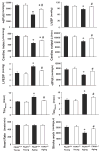Decreased age-related cardiac dysfunction, myocardial nitrative stress, inflammatory gene expression, and apoptosis in mice lacking fatty acid amide hydrolase
- PMID: 17434980
- PMCID: PMC2225473
- DOI: 10.1152/ajpheart.00373.2007
Decreased age-related cardiac dysfunction, myocardial nitrative stress, inflammatory gene expression, and apoptosis in mice lacking fatty acid amide hydrolase
Abstract
Recent studies have uncovered important cross talk between inflammation, generation of reactive oxygen and nitrogen species, and lipid metabolism in the pathogenesis of cardiovascular aging. Inhibition of the endocannabinoid anandamide metabolizing enzyme, the fatty acid amide hydrolase (FAAH), is emerging as a promising novel approach for the treatment of various inflammatory disorders. In this study, we have investigated the age-associated decline of cardiac function and changes in inflammatory gene expression, nitrative stress, and apoptosis in FAAH knockout (FAAH(-/-)) mice and their wild-type (FAAH(+/+)) littermates. Additionally, we have explored the effects of anandamide on TNF-alpha-induced ICAM-1 and VCAM-1 expression and monocyte-endothelial adhesion in human coronary artery endothelial cells (HCAECs). There was no difference in the cardiac function (measured by the pressure-volume conductance catheter system) between 2- to 3-mo-old (young) FAAH(-/-) and FAAH(+/+) mice. In contrast, the aging-associated decline in cardiac function and increased myocardial gene expression of TNF-alpha, gp91phox, matrix metalloproteinase (MMP)-2, MMP-9, caspase-3 and caspase-9, myocardial inducible nitric oxide synthase protein expression, nitrotyrosine formation, poly (ADP-ribose)polymerase cleavage and caspase-3/9 activity, observed in 28- to 31-mo-old (aging) FAAH(+/+) mice, were largely attenuated in knockouts. There was no difference in the myocardial cannabinoid CB(1) and CB(2) receptor gene expression between young and aging FAAH(-/-) and FAAH(+/+) mice. Anandamide dose dependently attenuated the TNF-alpha-induced ICAM-1 and VCAM-1 expression, NF-kappaB activation in HCAECs, and the adhesion of monocytes to HCAECs in a CB(1)- and CB(2)-dependent manner. These findings suggest that pharmacological inhibition of FAAH may represent a novel protective strategy against chronic inflammation, oxidative/nitrative stress, and apoptosis associated with cardiovascular aging and atherosclerosis.
Figures







References
-
- Adler A, Messina E, Sherman B, Wang Z, Huang H, Linke A, Hintze TH. NAD(P)H oxidase-generated superoxide anion accounts for reduced control of myocardial O2 consumption by NO in old Fischer 344 rats. Am J Physiol Heart Circ Physiol. 2003;285:H1015–H1022. - PubMed
-
- Ambrosini A, Zolese G, Ambrosi S, Ragni L, Tiano L, Littarru G, Bertoli E, Mantero F, Boscaro M, Balercia G. Oleoylethanolamide protects human sperm cells from oxidation stress: studies on cases of idiopathic infertility. Biol Reprod. 2006;74:659–665. - PubMed
-
- Batkai S, Jarai Z, Wagner JA, Goparaju SK, Varga K, Liu J, Wang L, Mirshahi F, Khanolkar AD, Makriyannis A, Urbaschek R, Garcia N, Jr, Sanyal AJ, Kunos G. Endocannabinoids acting at vascular CB1 receptors mediate the vasodilated state in advanced liver cirrhosis. Nat Med. 2001;7:827–832. - PubMed
Publication types
MeSH terms
Substances
Grants and funding
LinkOut - more resources
Full Text Sources
Medical
Molecular Biology Databases
Research Materials
Miscellaneous

